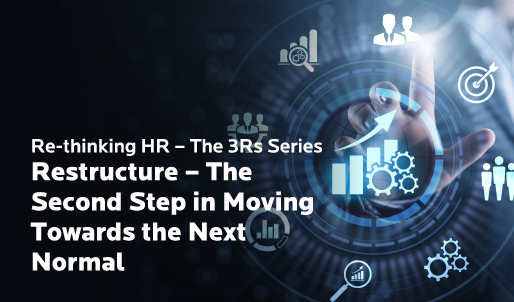Organizational structure is the sum of so many pieces, complexities, writing here about more than a couple would be asking you to read for more time than you have. So, we are consciously restricting this article. Please read on.
Restructure - The Second Step Towards the Next Normal
Let’s consider Restructuring, Step 2 of the 3Rs.
Now several months into this business disruption we are rapidly approaching those most important of annual cyclic events from an employee’s eyes: Performance Reviews, Rewards & Recognition. This is the first time we will have to pay rapt attention to impacts on people of things truly beyond their control or influence in such cycles.
The velocity of change has largely prevented updates to job duties and responsibilities. Standard competencies and skills of jobs have been expanded. Almost universally, proven measurements or tools are not in place to support subjective metrics on many of these important attributes. Things such as responsiveness, sense of urgency, availability, adaptability. A close look shows many of these were heretofore used in "support" jobs, the prime territory of service level agreements (SLAs).
Corporate reputations are on the line. The results and actions of these processes in this time will have long-term consequences on how people (not just employees but potential new hires and the public) view employers.
The HR Frontline: Certain Outcomes in Uncertain Times
As a result, we need to first and foremost determine how to best deliver on these processes. We need to restructure or reengineer them. However, time to make solid, future-looking, meaningful change to them just is not available.
Our recommendation is to make adaptations rather than another rushed reaction. These 2 employee experience processes touch more people at the same time than any other. In a period of unprecedented stress, these adaptations have an outsized impact. Nearly all other employee experience processes and tools will be forgotten.
Even if corporate coffers can’t afford promotions or pay raises in this period, don’t abandon reviewing performance. It is extremely important to know who the stars are and who, if anyone, is no longer a proper fit. Be honest with everyone, let them know that the purse strings are tight. Inform everyone what the coming annual process will be and how it will be conducted. Manage the change.
Performance reviews, 2020 style: Considerations and Recommendations
How do we fairly measure the performance of individuals who started the year with known responsibilities which have changed in priority or were completely replaced? Is a manager’s opinion sufficient and suitable? Can we truly rely on calibration as due diligence?
A recent Saratoga Institute benchmark report found that 55% of companies failed their own review of what they considered "good employee data". For those who have already moved to a form of performance appraisal known as "continuous performance management" or “continuous performance evaluation,” they felt they were "partway there", approximately 44% of those same companies.
Simply put, it was time for a change in how we “measure employee performance” before this chaos struck, now we must do so, our business survival largely rests in the hands of our employees. Always acknowledge and appreciate them.
So, what can we do for this cycle that will help with valid data points to consider? We here at Birlasoft recommend an approach like the following.
- As a priority, update employee goals, objectives, and observable skills
Review what was planned for relative value, those that impact now and further along the path to that next normal
Standard Deliverables
Meeting Due dates
Customer Communication / Service etc
- Replace those lesser important items, those not business/role imperative just now, with things such as:
Flexibility (adaptability, agility)
Picking up added responsibilities for the short & intermediate term
Change in Work Location
Work Shifts
Attitude (willingness, positivity)
Engagement
Teaming (co-operative spirit, collaboration)
Focus
- Along with those mentioned in earlier paragraphs here
Add topics for 100% (or mostly) remote work
Attendance/Participation in teleconferences/videoconferences
Diligence (on-time completion of work efforts)
- Change the “rating” process to be more coaching and forward-looking
Start, Stop, Continue
Use “levels” rather than scores (H, M, L)
- Conduct the first performance related “COVID Check-in”
Make changes, such as the above, officially and personally (1-1 video call, workplace meeting, etc.
- For the remainder of the current cycle have regularly scheduled (every 3 to 6 weeks) coaching sessions
Keep all session notes in an automated, on-going, running dialogue, document
** These updates/changes to responsibilities must be dynamic, able to be replaced, modified, updated, eliminated quickly due to ever-changing business imperatives.
This, most likely, restructured approach to the annual appraisal processes can and should still feed to your rewards & recognitions process/cycle.
You will still calibrate results, you will have more trend information, more relevant activities that show the concomitant business impacts. And as nearly all managers suffer from the “recency” effect to some degree, this approach plays directly into it. You’ll have a more frequent, more relevant, more lasting memory of these shorter periods of consideration.
(P.S. – Don’t forget to signup for 2 fee-free hours of consulting by completing the following.)
Thanks for continuing along this 3Rs journey with us. Next time we’ll be discussing Refocus, the 3rd R.
Until next time, I’m Terry.
"Now is the time to honor everyone's contributions and challenges, talk about how you’re going to move forward together."
Recommended



